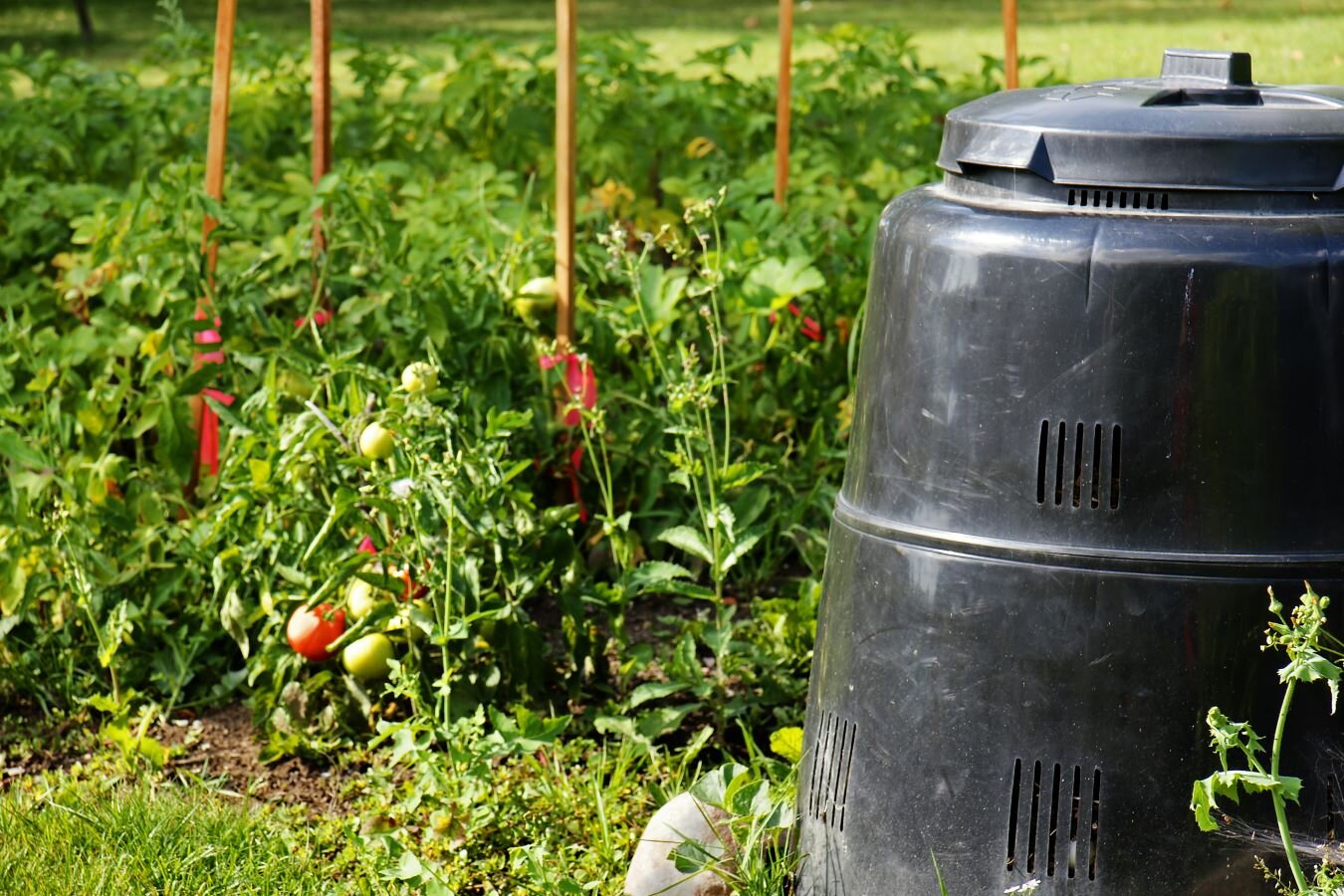How to Make More Compost and Cut Family Waste.
I’ve been composting in the traditional way since we moved into our first family home with a garden 4 years ago. I’ve always thought it was a brilliant way to use our kitchen scraps to make something good for our garden.
But here’s the thing. I never made nearly enough compost in a year to even touch the sides of our SMALL garden even as a family of 5, ending up buying a ton of compost from the garden center, which isn’t always cheap and of course comes in place bags (something I’m always trying to avoid). I’ve always wondered how I could up my composting game without it taking up a ton of space, costing the earth or being a faff. I’m not good with faffing. But now I believe I have found the answer.
Reduce you families kitchen waste and make a ton of easy, free compost by mixing traditional composting with Bokashi composting. This method will speed up your compost breaking down and use all your kitchen waste including meat, fish, carbs and dairy.
This is a great method for families or households with only a small outdoor area. Your Bokashi bin can also be kept in your kitchen without becoming smelly. Something that has been great for me when I don’t want to walk to the bottom of the garden in the rain while the kids are eating dinner with a smelly compost caddy.
How to increase your families compost yield.
Start a bokashi compost bin.
What is bokashi composting?
Bokashi composting is anaerobic (oxygen free) method of composting invented in Japan. It uses a specialist bran made up of beneficial microbes to ferment rather than discompose ALL kitchen waste, including meat and diary.
Bokashi composting has benefits in a small space as you can keep the bucket in your kitchen without it becoming smelly and will dramatically cut your household waste. I find it particularly great with young children who often do not eat everything on their plate or cut off crust on bread etc. Everything from pasta to fish bones, raw or cooked meat can go in. It means that the only waste now going into our regular kitchen bin is any un-recyclable packaging we are un-able to avoid. Previously when just using traditional composting methods we quiet often would take out the bin, not because it was full but because any scraps unable to go into our traditional compost bin would begin to smell. We can now pack down all packaging into 1 bin bag every few weeks if not less, really managing what we send to landfill. It’s a good feeling.
Read: Bokashi COmposting 101 here.
It also means that any waste (I would love to avoid any, this is simply not practical, especially with 3 children) is used to put something back into our garden. Making more compost is always a win for me.
The down side to Bokashi and why I was put off starting this system in the past is what you do once it has sat for two weeks fermenting.
Once it has completed this process it will still look like your original food scraps. You then need to dig it into the ground, or cover in some type of soil for a couple more weeks before it is completely broken down and ready to use on plants. However, with a small garden packed full of flowers I do not have space to do this. Neither would someone with no outdoor space or just a balcony. And also because I practice No Dig digging something into the ground kind of doesn’t sit right.
This is why I’m putting it into my traditional compost bin. Something you can do if you have a small garden with enough space for a small compost bin.
Mix your Bokashi COmpost in with your normal compost.
The next step is to put your fermented food from your Bokashi bin into your compost bin.
Adding Bokashi broken down food to your traditional garden compost bin will speed up your the composting process by 25%.
Carry on adding other material such as garden waste and carboard to you compost bin as you normally would along side you Bokashi.
You will need to mix the Bokashi compost into your compost bin, covering it will what is already in there or adding some extra soil from your garden on top. This is a good way to use up old potting soil. Save it for when you put your bokashi in, or just get a spade full from the garden. This process will also aerate you compost bin, accelerating the decomposing process again, observed in my own compost bin of up to 50%.
Aerate your compost bin.
Aerating your traditional compost bin alone can speed up the composting process. Aerating will also stop your composting bin becoming smelly. The smell of rotten eggs for example is a clear sign you need to aerate.
Aerating you composting bin, or turning it to allow oxygen to feed to microbes breaking down the waste inside, will also raise the temperature of you compost bin, speeding up the decomposition process more. Adding in Bokashi to this mix will speed up the process again because you are adding in more good microbes, the food is already partly broken down and your able to add more different types of organic matter. This increases the microbes as well as the volume you are putting in.
I have also found a benefit of adding Bokashi when adding in every 2-3 weeks as our family of 5 does means I aerate every 2-3 weeks when doing so. This seems to be the perfect frequency for aerating my compost bin. Because obviously otherwise I forget.
I use a cock screw aerator (like this one) which I love because it’s so easy to use limits any worms coming to harm, however you can just use a garden fork if you have one to hand. Simple turn the compost as best as possible bring the more decomposed matter up from the bottom to cover the newly added stuff at the top.
Collect extras from your neighbours.
Another great way to add extra bulk and nutrients to you compost bin is to ask your neighbours for extra grass clippings. However I want you to do this with caution. You would be surprised at how many of your friends and neighbours spray their lawns with chemical fertilizers or weed killers. Casually ask them if they do this, slip it into the conversation before you ask for their cuttings. Most neighbours unless composting themselves will be happy to give you their grass clippings but if they do spray chemicals this could really damage your future crops.
In this Youtube Video from the lovely and brilliant Charles Dowding he talks about how careful we need to be after buying manure from friends to find the grass the horses had eaten contained some type of fertilizers. He shows the growth of some of this plants grown without this manure and some with, the difference in growth was quiet staggering. It’s a sad fact but Charles explains how he now tests all organic matter he brings into his garden in this way to see if it is contaminated.
My own personal method of composting quickly from start to finish.
I’ve now explained why I do what I do to make my composting yield far bigger but I feel it is far easier to understand when you see how this works day to day with my own personal method from a family of 5.
Have 2 compost bins and 2 Bokashi bins.
For the past 4 years I have had two traditional compost bins (the small plastic ones that looks like darlecs. See my post of “Composting for Beginners” to get started with this.) I have used the process of filling one for year, then letting it break down for a year while I filled the second. However, these never fully broken down in a year and never produced enough for my garden, though was of course great for all our veg and garden waste.
Now even with a quicker process in place find it best to have two bins as well as two Bokashi bins. In the same way I fill a Bokashi bin in the kitchen which takes roughly 2-3 weeks, set this one aside to ferment for 2-3 weeks while I fill the second.
Add your Bokashi to your already full compost bin aerating as you go.
I then add my fermented Bokashi to the full and decomposing compost bin. I carry on adding garden scraps, cut flowers, grass clipping and carboard to the second compost bin. This is because the first one is already in the breaking down process making it easier to aerate, turn, and add the bokashi too. The process is fully accelerated by doing this, so instead of waiting a year before I can use this compost I can wait a matter of months. I’m aiming to have a full yield from one compost bin every 6 months, meaning I can mulch my garden in the spring and the autumn.
Then switch it around.
Once I have harvested the first compost bin I will begin adding my Bokashi to the second, putting garden waste etc into the now empty bin.
What to do if you have yet to start any composting.
Just start. Get yourself an outdoor compost bin. Yes, if you have yet to start anything you’ll be wondering how to add in Bokashi if there is nothing to turn it into but it won’t take long before your at this stage. In the mean time you could put you Bokashi straight into the ground, into a container and cover in soil, or add a layer of Bokashi then a layer of soil to your compost. Ask neighbours, friends and family if they have waste you can throw into your compost pile to get the second one going too (of course making sure there’s no chance of fertilizers.) You could even clear your local park of some leaves to add in. (Do not do this is wooded areas as the trees need the nutrients and ground cover too, but your local park ranger will be grateful to you helping to clear grassy areas of leaves he would have had to do himself. Back alley ways behind your house are also a good place to look for these.) Ask your local coffee shop for some coffee grounds, get your mother-in-law to save her potato peels, ask a local tree surgeon for some wood chips. Anything extra you can put in will of course improve the amount of compost you make. And of course save it from heading to landfill or be incinerated.
Have you started your own compost bin yet? Fancy adding Bokashi into the mix as well? Or will aerating to speed things to be good enough for you?
You also might enjoy.
Bokashi Composting 101. Dramatically Cut Your Families Waste.
11 Activities for Kids to Help Wildlife and Bio-Diversity in your Garden.
A Beginners Guide to Growing a Sustainable Herb Garden.
Why you don’t need to a Hippy to be an Eco-Activist.
How Community could be the Answer to a Sustainable New World.

